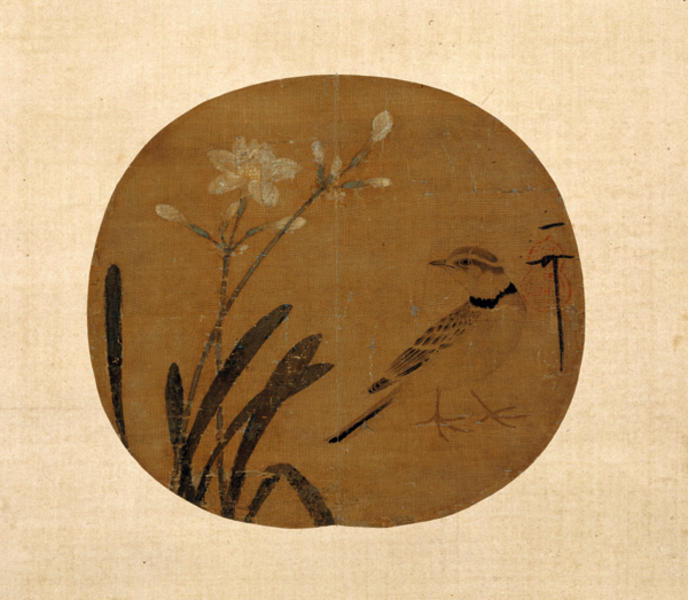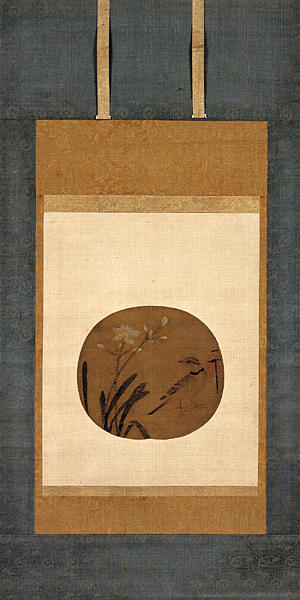水仙小禽図(伝・徽宗筆)
- 中国・南宋時代
- 13c
- 絹本著色、団扇形
- H-24.3 W-27
中国・南宋時代 13世紀
絹本著色
団扇形 縦:24.3cm 横:27.0cm
花を咲かせる水仙とそのかたわらに舞い降りた一羽の小禽を大写しに描く。小禽は雀に似た羽毛であるが,やや細身で,首筋の黒い輪に特徴がある。羽毛は細く淡い線で毛描きし,一部に淡墨・淡彩を掃く。この種のものとしては,伝宋汝志筆の雛雀図(東京国立博物館蔵)があるが,さらに柔らかく流麗である。
水仙は,葉の部分では輪郭線をあまり目立たせず一見没骨風に,花の茎・萼では輪郭線をはっきりさせ,描法に変化をつけている。葉の黒ずんだ部分は補絹で,絹目も全く異なる。小禽の首の黒い輪の左手半分や尾の先の黒い部分はやや墨調が異なり,あるいは補筆のようにも見うけられる。
小禽のすぐ右手に,宋徽宗の「天下一人」の花押があり,これに重ねて「御書」朱文葫蘆印が押されている。
興味深いことに,本図の水仙と花や葉の形姿が近似する徽宗の作品が台北の故宮博物院にある。『石渠宝笈三編』延春閣に著録される蝋梅山禽図で,枝につがいの白頭翁を止まらせる蝋梅の根元に水仙を寄せ,黄蜂が一匹そのまわりを飛ぶ写生風の作品である。
花茎は二本で,おのおの四つ,全部で八つの莟のうち,一つのみが花弁を開く水仙の様子は,この両者の間に,徽宗の原作品を軸にした何らかの関わりを感じさせる。
「水仙鳥徽宗皇帝筆」とする狩野永真の極めがつく。 (西上)
Catalogue Entry
Attributed to the Emperor Huizong
China, Southern Song dynasty, 13th century
Hanging scroll, color on silk, fan shaped
Height, 24.3cm; width, 27.0cm
This circular fan painting shows a close-up view of a blossoming spray of narcissus and a small bird turning back to look at the flowers. While the bird has wing markings that resemble those of a sparrow, it is relatively slender and has a black ring on its neck. The wings are picked out in thin, lightly brushed strokes, and a section has been brushed with light ink and light color. A similar work can be seen in the Young Sparrows attributed to Song Ruzhi (Tokyo National Museum), but here the depiction is even softer and more refined.
The outlines on the leaves of the narcissus are so faintly drawn that at first glance they appear to have been painted in a "boneless" style, while the stems and buds of the flowers are drawn with clearly depicted outlines, indicating a mixture of styles. The blackened areas of the leaves are later additions of silk, and this added silk weave is completely different from the original silk surface. The left half of the black ring around the bird's neck and the black section at the end of the tail show an ink tone that differs from that of the rest of the painting, and these areas appear to be later brushwork.
Immediately to the right of the bird is the Song Emperor Huizong's written seal layered with his red letter gourd-shaped seal.
The fascinating element of this work is the fact that a painting in the National Palace Museum, Taiwan, by Huizong includes narcissus flowers and leaves that resemble those seen here. The Allspices and Wild Birds recorded by Enshunkaku in the Sekiryo Hokyu volume 3 shows a couple of birds on an allspice plum tree and narcissus blooming at the foot of the tree. This realistic painting goes on to show a single yellow bee flying around the tree. These 2 works each depict 2 stems of flowers, each with 4 buds and with one of the flowers in full bloom. This similarity between the 2 works shows that they probably stood in some relationship to an original work by the Song emperor.
This painting is accompanied by an authentica-tion statement by Kano Eishin (Yasunobu 1613-85) stating that it is a painting of a narcissus and bird by the Emperor Huizong. MN

